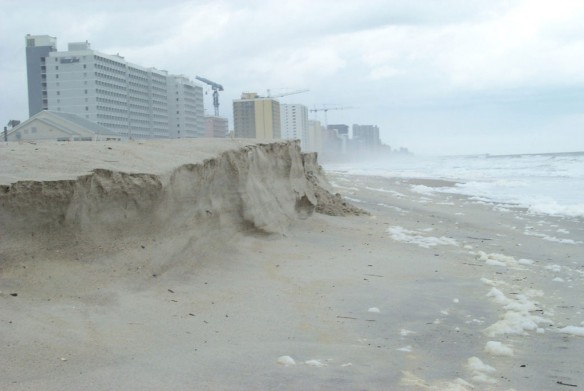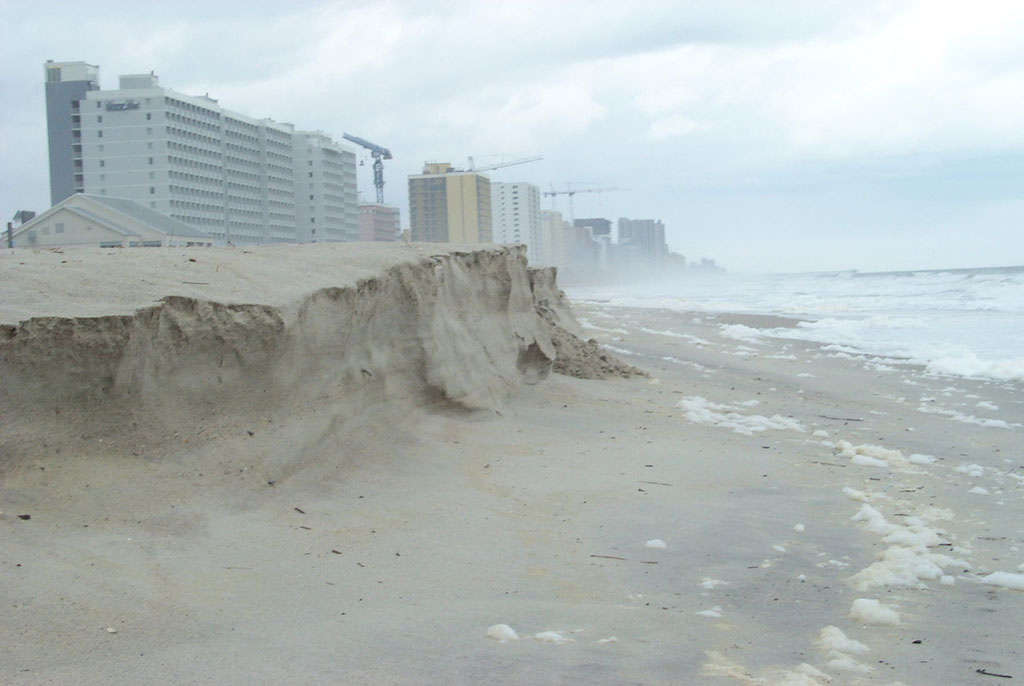
Myrtle Beach erosion, SC. Photo source: ©© Randy.
“Development is absolutely responsible for the majority of the beach nourishment,” Andrew Coburn, assistant director of The Program for the Study of Developed Shorelines at Western Carolina University, said. “Well over 99 percent of the shorelines that are nourished are developed so there is some economic value placed behind them.”
Excerpts;
Severe weather events this summer washed away hundreds of acres of sand, ripped apart walkways and stairs leading over fragile dunes, and caused significant erosion to the natural barriers that protect inland areas from coastal flooding.
The trifecta in recent weeks of storm surge from Hurricane Joaquin, king tides, and nearly 2 feet of record rainfall, contributed to the loss of nearly 80 percent of the sand that replenished North Myrtle Beaches during the last renourishment project in 2008. This project to replenish the beaches with 750,000 cubic yards of sand cost nearly $11 million…
Read Full Article, Myrtle Beaches Online
The Changing Carolina Coast: Sand Is Everywhere, Except When It Isn’t, WUNC (06-02-2015)
Endless Erosion Battle a Matter of Money, The St Petersburg Tribune (07-21-2014)
Sandbagged: The Undoing of a Quarter Century of North Carolina Coastal Conservation, Op Ed by Gary Lazorick (07-04-2011)
Rows of houses with overlapping sandbag walls create huge problems. The walls do as much damage to the beach as hardened seawalls. Removing the sandbags from one property potentially damages all of the others…
Sea Level Rise Accelerating In U.S. Atlantic Coast, USGS (06-25-2012)
Scientists Foresee Losses as Cities Fight Beach Erosion, Climate Central (09-14-2015)
A New Report Lays Bare the Effects of Climate Change on the N.C. Coast, IndyWeek (04-09-2015)
Watching The Rising Tides Along North Carolina’s Coast, (11-15-2013)
Professor Robert Young, director of the Program for the Study of Developed Shorelines and a professor of coastal geology at Western Carolina University, with North Carolina Public Radio host Frank Stasio, discussing the consequences of climate change and how rising sea levels have a strong effect on the beaches of North Carolina…
“North Carolina: The Beaches Are Moving,” A Video featuring Orrin Pilkey, PhD
World famous coastal geologist Orrin H. Pilkey takes us to the beach and explains why erosion has become a problem…
Is Beach Renourishment Worth The Money? WWAY News (02-16-2015)
Pilkey’s Call: Save The Beaches; News Observer (08-09-2015)
Beaches move, and with rising sea levels they are moving faster. People try to slow or halt the process by dredging up sand or erecting imposing seawalls, but those are destructive and doomed efforts. To save the beaches, we must let beaches go where and how they want…
Palm Beach Mid-Town Dredge Project, A Youtube Video (02-04-2015)
“Beach nourishment projects like this have become commonplace along the US East and Gulf Coasts. These projects have immediate environmental impacts through burial of nearshore habitat and increased turbidity during project placement.The cumulative environmental impacts of doing this repeatedly on the same beach while conducting projects from Maine to Texas is unknown. But, we should be concerned. ” —Robert S. Young, PhD, Director, Program for the Study of Developed Shorelines, Professor, Coastal Geology, Western Carolina University
North Carolina Should Move With Nature on Coast, News Observer (01-05-2015)









